Travel E-Logs #6: Santa Cruz
Dear students:
Saludos desde Puerto Ayora de la isla Santa Cruz! In this report, we're going to pick up right where we left off in the last one -- exploring the topic of names. Last time, we looked at the names of various islands, islets and rocks in the Galapagos Archipelago. Well, we've noticed that some other things floating in the ocean around here all have names, too. Here's a sampling of them (with English translations in parentheses):
Rodnay
IX 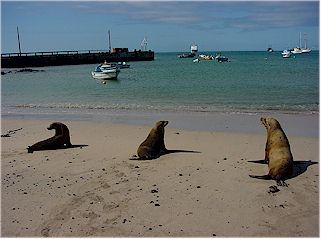
Beagle III
TR63
Petrel Alta (Tall One)
Pirata (Pirate)
Maria Isabela
Eclipse
Leonel
Antartica
Delfin (Dolphin)
Reina Silvia (Queen Silvia)
Ciclon (Cyclone)
Aida Maria
Darwin
Angelito (Little Angel)
Galapagos Explorer
Galapagos Adventure
Have you figured out what these floating things might be? Boats, of course. Here they are part of the every day scenery and Lilia and I found it quite interesting that each one has a name, as if it were a member of the family or a pet. Some people name their cars, of course, but there is a much stronger tradition of naming a boat. What would you name your boat, if you had one all to yourself?
===================================
Some other things we've encountered here a lot also have interesting names. Here's a list of ones found in the archipelago that you might not be familiar with. See if you can guess what they are considering their names:
Wandering
Tattler
Red Knot
Sanderling 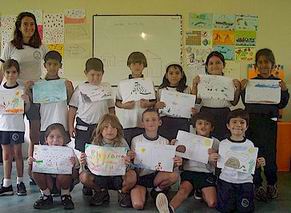
Sora Rail
Ruddy Turnstone
Marbled Godwit
Purple Gallinule
Common Noddy
South Polar Skua
Figure it out yet? OK, we'll give you some that might paint a clearer picture for you:
Red-necked
Phalarope
Black-necked Stilt
Wedge-tailed Shearwater
White-faced Storm Petrel
White-cheeked Pintail
Paint-billed Crake
Short-billed Dowitcher
Lesser Yellowlegs
Got it? OK, how about these?
Waved
Albatross
Red-footed Booby
Galapagos Penguin
Brown Pelican
Greater Flamingo
Magnificent Frigatebird
Flightless Cormorant
Of course, we're talking about birds! What do their names tell you about their habits, habitat or physical features? We think their descriptive names are really neat. But getting a chance to see them up close and in action is even neater....
=====================================
The other day, late in the afternoon, we went for a swim in a little mangrove cove, separated from the open ocean by a circle of rocks with a small opening for boats to get through. As we were swimming, a huge school of small fish entered the cove through the opening and started swimming around with us. We thought that was pretty exciting in and of itself, but then, out of nowhere, a squadron of eleven blue-footed boobies swung over the cove and started dive-bombing the fish, right next to us. Sometimes they would dive individually and sometimes in unison, the males making a whistle and the females making a honk just before they dove when they spotted the school. In a few cases, the boobies swooped within a yard of us or plunked down into the water and then popped back up with a fish or two just a few yards away. We thought it was amazing that they acted as if we weren't even there -- and we were happy that their aim was true. We were also awed by their incredible eyesight. They could spot the tiny fish from twenty or thirty feet in the air, whereas we had to squint right at the water's surface to see them.
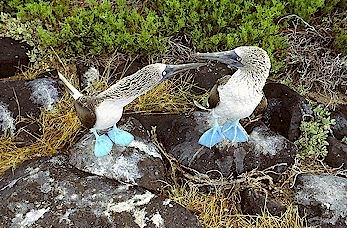 Boobies
weren't the only animals cashing in at the cove. A young sea lion followed the
school in and performed a dizzying display of high-speed, acrobatic loops, chasing
after the stream of small fish. He too acted like we weren't even there. Even
some of the pelicans who had already punched their time-cards, perching in the
branches of the mangroves and drying their wings after a day of fishing, opted
for the free dessert, plopping down into the water and scooping up a billful
of little squirmers. Lilia, swimming underwater with her goggles on, spotted
a big, flat white sack-like thing gliding past. A giant white manta ray? We
didn't stick around to verify. But, we did stay up on the dock for a long time
afterwards, watching the amazing boobies.
Boobies
weren't the only animals cashing in at the cove. A young sea lion followed the
school in and performed a dizzying display of high-speed, acrobatic loops, chasing
after the stream of small fish. He too acted like we weren't even there. Even
some of the pelicans who had already punched their time-cards, perching in the
branches of the mangroves and drying their wings after a day of fishing, opted
for the free dessert, plopping down into the water and scooping up a billful
of little squirmers. Lilia, swimming underwater with her goggles on, spotted
a big, flat white sack-like thing gliding past. A giant white manta ray? We
didn't stick around to verify. But, we did stay up on the dock for a long time
afterwards, watching the amazing boobies.
Another day, we visited another cove, this one surrounded by a beautiful beach. Again, the birds stole the show. Lilia and I had put our things next to a lone mangrove tree in the middle of the beach and went out for a swim. While we were snorkeling, a small boat with three fisherman passed by, followed by a trail of frigate birds and a pack of pelicans. The fisherman landed the boat and hauled their haul, a crateful of ojones (foot-long fish with bulging brown eyes after which they get their Spanish name) up onto beach. They sat in the shade of the mangrove tree and started to clean the fish, the pelicans lining up in front of them on the beach and the frigate birds circling around them overhead. As the men cleaned the fish, they tossed the fish guts up -- and the frigate birds came swooping down, snatching the guts right out of the air. Or, if the frigate birds missed, the pelicans would go scrambling after the guts, snapping and moaning at their pelican competitors.
Lilia and I finished our swim and, since we had set up near the mangrove tree, got a front row seat for this spectacle. Some of the frigate birds brushed Lilia's head, shoulders and arms as they dove for the guts. A squabbling pelican bumped into me, as if I was another pelican, and another stepped right on my foot. But we enjoyed the show. After a while, a bunch of people gathered around to watch. One of the pelicans, not satisfied with having to fight over nibbles of fish intestines, would occasionally steal a whole fish from the crate, to the laughter of all those gathered. The fishermen even let a few children give some of the smaller fish to the pelicans. One girl was teasing the pelicans with a fish, holding it out for them then pulling it back when they snapped at it. She laughed, holding the fish up over her head as the pelicans lunged -- till a frigate bird swooped down from behind her and snatched the fish out of her hands, giving her quite a shock.
=======================================
Do you recognize any these names?
Blue-winged
Teal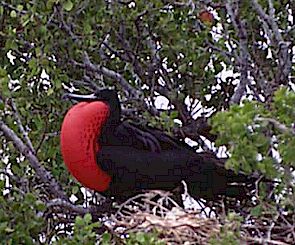
Great
Blue Heron
Osprey Peregrine
Falcon Killdeer
Common Nighthawk
Eastern Kingbird
Barn Owl
Belted Kingfisher
Red-eyed Vireo
Cedar Waxwing
Purple Martin
Barn Swallow
Cliff Swallow
Yellow Warbler
Blackpoll Warbler
Rose-breasted Grosbeak
Bobolink
There's a pretty good chance that some or most of these birds, which can all be found in the Galapagos, also live near you, since they are all common North American birds. So, how did they get to the Galapagos? Well, some, known as residents, like the Barn Owl, the Great Blue Heron and the Yellow Warbler, live all year round in the Galapagos, but also can be found in other regions of the world. Others, known as migrants, like the Osprey, the Peregrine Falcon and the Barn Swallow, are only found on the islands for part of the year, usually during the northern winter. Still others, known as vagrants, like the Eastern Kingbird, the Red-eyed Vireo and the Cedar Waxwing, only stop on the islands occasionally, either on their way to another place or because they are lost.
There's one other category of birds found in the Galapagos: endemic birds. These are resident birds that do not normally breed anywhere else in the world. Of the 58 residential Galapagos birds, 28 are endemic. These include the Galapagos Penguin, the Lava Heron, the Waved Albatross, the Lava Gull, the Galapagos Flycatcher and all thirteen of Darwin's Finches.
===================================
Of course, all birds have Spanish names and Latin or scientific names, too. See if you can match the English bird names with their Spanish/Latin counterparts. In most cases, you'll find a linguistic clue that will help you make the match. We'll list the answers in the next report.
Match Them Up:
| 1. Medium Ground Finch | A. Pinguino de Galapagos/Spheniscus mendiculus |
| 2. Large Cactus Finch | B. Fragata Magna/Fregata magnificens |
| 3. Flamingo | C. Gavilan de Galapagos/Buteo galapagoensis |
| 4. Magnificent Frigate Bird | D. Piquero Patas Rojas/Sula sula |
| 5. Red-footed Booby | E. Pinzon Cactero Grande/Geospiza conirostris |
| 6. Brown Pelican | F. Cormoran No Volador/Nannopterum harrisi |
| 7. Galapagos Penguin | G. Pinzon Terrestre Mediano/Geospiza fortis |
| 8. FlightlessCormorant | H. Pelicano Pardo/Pelecanusoccidentalis |
| 9.Great Blue Heron | I. Flamenco/ Phoenicopterus ruber |
| 10. Galapagos Hawk | J. Garzon Azulado/Ardea herodias |
====================================
Below are two more photos of our Mystery Animal, which we'll reveal in the next report. Also, don't forget to vote for the cutest Galapagos animal on our new Web site section, Cutest of the Cute, located here.
Move your mouse over the photo to see another one, and guess-who!
====================================
We'll end this report with some more answers to your questions, again this time provided by second, fifth and sixth graders at the Tomas de Berlanga School on Santa Cruz:
What
kind of food do you eat and where do you get it?
We eat fish and all kinds of seafood from the ocean; meat
and vegetables from the island highlands; and rice, fruits, potatoes, chicken,
canned goods, sugarcane, candy and chocolate from the mainland of Ecuador. A
few other specialty items are imported from other countries.
What do your schools teach, how long is your school day/year,
and how many children are there in your class in school?
Everyday we are in school for five and a half hours and
we spend 200 days a year in school. In our class, there are 9 students.
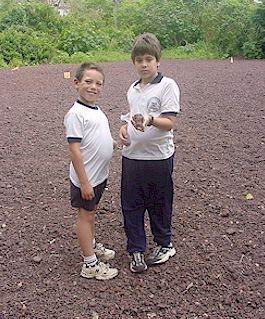 What
do your houses look like?
What
do your houses look like?
Some of our houses are made of cement, and some others
are made of lava rocks or wood. Most of them are rectangular with a triangular
rooftop. A lot of them are painted white. Some are gray or black and white.
Some have tin roofs and some have tile roofs.
What
language do you speak?
We speak Spanish, but some of us also speak English and
French.
What
is it like to live on an island?
It's beautiful. There are not many cars. There are many
animals. We have nice beaches too. We all like living here.
Did
your island ever have a war?
Never. We do have a military base though, which was originally
set up by the US during World War II.
What
kind of toys do you have and what games do you play?
We play computer games and some of us have play stations
and Game Boy. Some of us have stuffed animals, Barbie dolls, and model airplanes/trains.
We like to play soccer, basketball, and volleyball, too.
What holidays do you celebrate?
We celebrate Christmas, Carnival, Halloween, Easter, Valentine's
Day, the Day of the Dead, Fiesta of Santa Cruz, Mother's Day, Father's Day,
Childre's Day, Teacher's Day, Environment Day and Arbor Day.
Why
do they call them push-me pull-me iguanas?
We have never heard of push-me pull-me iguanas. [Note
from Paul. We'll keep trying to get you the answer on this one.]
==============================
Well, that's all for this report. In the next one, we'll meet Santu Cruz's most famous resident: Lonsesome George. Till then....
Learn lots,
Paul
==============================
Index
Page
Meet the Adventure Team
E-Log#1:
New York
E-Log#2: Quito, Ecuador
E-Log#3:
San Cristobal, Galapagos
E-Log#4:
San Cristobal, Galapagos
E-Log#5: Santa Cruz
E-Log#6: Santa Cruz
E-Log#7:
Santa Cruz
E-Log#8:
Isabela Island
E-Log#9:
Isabela
© 2007 OneWorld Classrooms. Text by Paul Hurteau. Photos by Dennis Pippen, Lilia Cai and Miguel Mosquero. All rights reserved.